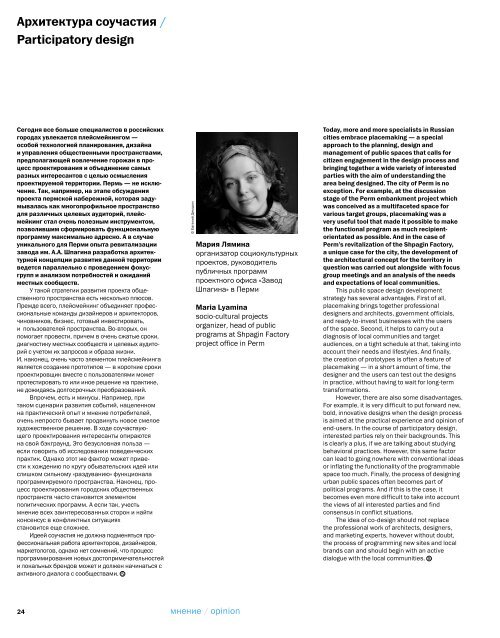speech: 21 community centre
ISBN 978-3-86859-848-3 https://www.jovis.de/de/buecher/product/speech-21.html
ISBN 978-3-86859-848-3
https://www.jovis.de/de/buecher/product/speech-21.html
Create successful ePaper yourself
Turn your PDF publications into a flip-book with our unique Google optimized e-Paper software.
Архитектура соучастия /<br />
Participatory design<br />
Сегодня все больше специалистов в российских<br />
городах увлекается плейсмейкингом —<br />
особой технологией планирования, дизайна<br />
и управления общественными пространствами,<br />
предполагающей вовлечение горожан в процесс<br />
проектирования и объединение самых<br />
разных интересантов с целью осмысления<br />
проектируемой территории. Пермь — не исключение.<br />
Так, например, на этапе обсуждения<br />
проекта пермской набережной, которая задумывалась<br />
как многопрофильное пространство<br />
для различных целевых аудиторий, плейсмейкинг<br />
стал очень полезным инструментом,<br />
позволившим сформировать функциональную<br />
программу максимально адресно. А в случае<br />
уникального для Перми опыта ревитализации<br />
завода им. А.А. Шпагина разработка архитектурной<br />
концепции развития данной территории<br />
ведется параллельно с проведением фокусгрупп<br />
и анализом потребностей и ожиданий<br />
местных сообществ.<br />
У такой стратегии развития проекта общественного<br />
пространства есть несколько плюсов.<br />
Прежде всего, плейсмейкинг объединяет профессиональные<br />
команды дизайнеров и архитекторов,<br />
чиновников, бизнес, готовый инвестировать,<br />
и пользователей пространства. Во-вторых, он<br />
помогает провести, причем в очень сжатые сроки,<br />
диагностику местных сообществ и целевых аудиторий<br />
с учетом их запросов и образа жизни.<br />
И, наконец, очень часто элементом плейсмейкинга<br />
является создание прототипов — в короткие сроки<br />
проектировщик вместе с пользователями может<br />
протестировать то или иное решение на практике,<br />
не дожидаясь долгосрочных преобразований.<br />
Впрочем, есть и минусы. Например, при<br />
таком сценарии развития событий, нацеленном<br />
на практический опыт и мнение потребителей,<br />
очень непросто бывает продвинуть новое смелое<br />
художественное решение. В ходе соучаствующего<br />
проектирования интересанты опираются<br />
на свой бэкграунд. Это безусловная польза —<br />
если говорить об исследовании поведенческих<br />
практик. Однако этот же фактор может привести<br />
к хождению по кругу обывательских идей или<br />
слишком сильному «раздуванию» функционала<br />
программируемого пространства. Наконец, процесс<br />
проектирования городских общественных<br />
пространств часто становится элементом<br />
политических программ. А если так, учесть<br />
мнение всех заинтересованных сторон и найти<br />
консенсус в конфликтных ситуациях<br />
становится еще сложнее.<br />
Идеей соучастия не должна подменяться профессиональная<br />
работа архитекторов, дизайнеров,<br />
маркетологов, однако нет сомнений, что процесс<br />
программирования новых достопримечательностей<br />
и локальных брендов может и должен начинаться с<br />
активного диалога с сообществами.<br />
© Евгений Демшин<br />
Мария Лямина<br />
организатор социокультурных<br />
проектов, руководитель<br />
публичных программ<br />
проектного офиса «Завод<br />
Шпагина» в Перми<br />
Maria Lyamina<br />
socio-cultural projects<br />
organizer, head of public<br />
programs at Shpagin Factory<br />
project office in Perm<br />
Today, more and more specialists in Russian<br />
cities embrace placemaking — a special<br />
approach to the planning, design and<br />
management of public spaces that calls for<br />
citizen engagement in the design process and<br />
bringing together a wide variety of interested<br />
parties with the aim of understanding the<br />
area being designed. The city of Perm is no<br />
exception. For example, at the discussion<br />
stage of the Perm embankment project which<br />
was conceived as a multifaceted space for<br />
various target groups, placemaking was a<br />
very useful tool that made it possible to make<br />
the functional program as much recipientorientated<br />
as possible. And in the case of<br />
Perm’s revitalization of the Shpagin Factory,<br />
a unique case for the city, the development of<br />
the architectural concept for the territory in<br />
question was carried out alongside with focus<br />
group meetings and an analysis of the needs<br />
and expectations of local communities.<br />
This public space design development<br />
strategy has several advantages. First of all,<br />
placemaking brings together professional<br />
designers and architects, government officials,<br />
and ready-to-invest businesses with the users<br />
of the space. Second, it helps to carry out a<br />
diagnosis of local communities and target<br />
audiences, on a tight schedule at that, taking into<br />
account their needs and lifestyles. And finally,<br />
the creation of prototypes is often a feature of<br />
placemaking — in a short amount of time, the<br />
designer and the users can test out the designs<br />
in practice, without having to wait for long-term<br />
transformations.<br />
However, there are also some disadvantages.<br />
For example, it is very difficult to put forward new,<br />
bold, innovative designs when the design process<br />
is aimed at the practical experience and opinion of<br />
end-users. In the course of participatory design,<br />
interested parties rely on their backgrounds. This<br />
is clearly a plus, if we are talking about studying<br />
behavioral practices. However, this same factor<br />
can lead to going nowhere with conventional ideas<br />
or inflating the functionality of the programmable<br />
space too much. Finally, the process of designing<br />
urban public spaces often becomes part of<br />
political programs. And if this is the case, it<br />
becomes even more difficult to take into account<br />
the views of all interested parties and find<br />
consensus in conflict situations.<br />
The idea of co-design should not replace<br />
the professional work of architects, designers,<br />
and marketing experts, however without doubt,<br />
the process of programming new sites and local<br />
brands can and should begin with an active<br />
dialogue with the local communities.<br />
24 мнение / opinion


















